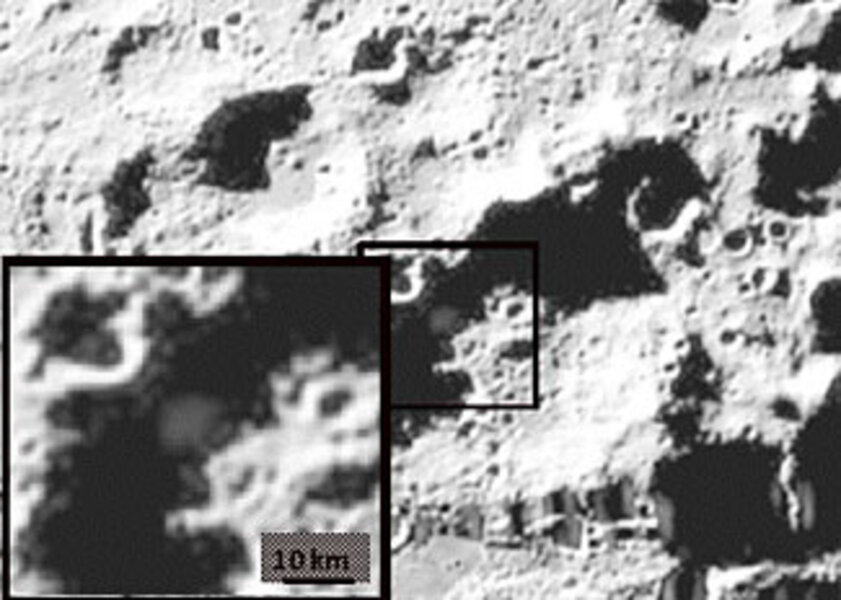Water on the moon: Eureka! They've found it!
NASA's mission to crash a rocket into a crater to find water on the moon found it – and much more.
Scientists with NASA's LCROSS mission, which sent an impactor hurtling into Cabeus Crater on Oct. 9, say their results turned up a significant amount of water in the plume of material the crash kicked up.
The team is still trying to come up with an estimate of the water content of the spot the spent Centaur upper stage struck. The collision generated a plume roughly six miles across. LCROSS's instruments could sample only a tiny part of that plume. But within that tiny field of view, the team detected nearly 27 gallons of water – either as water vapor or ice grains.
"That's probably a lower bound on the total amount of water we've seen here," says Anthony Colaprete, project scientist for the mission.
The excitement over finding potentially significant amounts of water centers on water's value as a resource for explorers – either to drink or to split in to oxygen and hydrogen for rocket fuel. It's also revolutionizing humanity's understanding of its familiar neighbor – shifting the picture from a geophysically dead object to one that is "very complicated, very dynamic, and very fun to study," says Dr. Colaprete. "It's not just about water anymore."
The data also harbor tantalizing evidence of what appear to be carbon-based compounds in the ejected material. These may include carbon dioxide, methane, ethanol, and other organics. While the team hasn't had time to sort through those data yet, the researchers say the chemical fingerprints their spectrometers picked up look strikingly like those from ancient, icy bodies in the outer solar system.
Polar craters like Cabeus are among the coldest places in the solar system because some crater floors never see sunlight. So they freeze out and accumulate so-called volatiles – compounds that in a vacuum flash from ice to gas with only a tiny increase in temperature.
These craters may collectively represent "the dusty attic of the solar system," says Michael Wargo, NASA's chief lunar scientist. That "attic" could harbor chemical artifacts from billions of years ago – evidence that could help scientists piece together the story of the solar system's evolution.
All of this "is giving us a surprising new picture of the moon," adds Greg Delory, a planetary scientist at the University of California at Berkeley. "This is not your father's moon!"
For all the excitement about water, the moon is still a dry, desolate place. In September, teams pooling data from several lunar orbiters, including India's Chandrayaan-1 and NASA's Lunar Reconnaissance Orbiter, found evidence for water. But the water either is bound up in minerals on the lunar surface or appears as hydroxyls – molecules one hydrogen atom short of H2O.
They found this evidence over much of the moon's surface. But an explorer would have to process a ton of soil to wring out roughly a quart of water.
In contrast, the bottom of Cabeus Crater seems to harbor an oasis. The team cautions that this dampness is relative. The crater is about as dry as Chile's Atacama Desert – one of the driest places on Earth. But from a human-exploration perspective, Dr. Wargo adds that "if there's a choice of having no water available to you and a little bit of water available to you compared with our Earth-based environment, I'll take the situation where we have a little bit of water available."
Water's presence, along with what could turn out to be basic organic compounds in polar craters, raises intriguing questions, Dr. Delory says. Where did the water come from? How long has it been there? What processes put it there, modify it, and destroy it?
Possible answers include the moon's version of a water cycle, where the solar wind helps build the inventory of hydroxyls, which freeze out at night and then thaw during the lunar day to migrate toward the poles, where it once again is trapped. A comet could have delivered some of the material. Or some of the water could have originated on the moon itself from processes taking place in its interior.
"It's when we get at these processes that we'll begin to understand the story that the lunar polar region has to tell about the moon's history, our own history, and about early conditions in the solar system," Delory says.
----
See also:
NASA moon bombing successful. Did we find water?
NASA moon 'bombing' a plunge into the mystery of lunar water
----
Follow us on Twitter.





